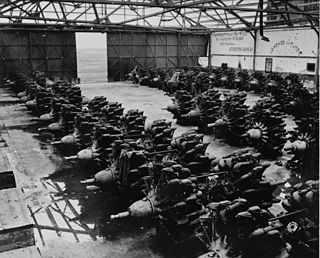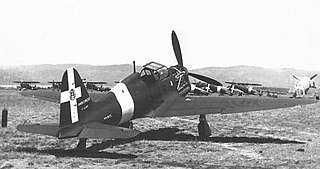Related Research Articles

The Piaggio P.XI was an Italian 14-cylinder radial aircraft engine. The P.XI was a licensed derivative of the French Gnome-Rhône Mistral Major 14K produced in Italy. Isotta Fraschini also produced a version of the 14K called the K.14.

The Delta was a 12-cylinder inverted-V aircraft engine built by Isotta Fraschini prior to and during World War II.

The Gnome-Rhône 14K Mistral Major was a 14-cylinder, two-row, air-cooled radial engine. It was Gnome-Rhône's major aircraft engine prior to World War II, and matured into a highly sought-after design that would see licensed production throughout Europe and Japan. Thousands of Mistral Major engines were produced, used on a wide variety of aircraft.

The Alfa Romeo 115 was an Italian six-cylinder air-cooled inverted inline engine for aircraft use, mainly for training and light planes, based on the de Havilland Gipsy Six engine. Production totalled approximately 1,600 units. Derivatives of the 115 include the -1, bis, ter and Alfa Romeo 116.

The Alfa Romeo 110 was an Italian four cylinder air-cooled inverted inline engine for aircraft use, mainly for trainers and light aircraft. The Alfa Romeo 110 was based on the de Havilland Gipsy Major, with approximately 500 units produced. Derivatives of the 110 include the -1, ter and Alfa Romeo 111.

The Ambrosini SAI.207 was a light fighter interceptor built entirely from wood and developed in Italy during World War II. Powered by a single 750 hp Isotta Fraschini Delta, the SAI.207 enjoyed limited success during evaluation of the 12 pre-production aircraft.

The Argus As 410 was a German air-cooled inverted V-12 light aircraft engine that was first produced by Argus Motoren in 1938.

The SAI-Ambrosini SS.4 was an Italian fighter prototype developed in the late 1930s, featuring a canard-style wing layout and a pusher propeller. Development of the SS.4 was abandoned after the prototype crashed on its second flight.

The Asso XI was a family of water-cooled, supercharged V12 piston aeroengines produced in the 1930s by Italian manufacturer Isotta Fraschini, and fitted on a number of aircraft types built by CANT, Caproni and others.

The Walter Sagitta was a Czechoslovakian, air-cooled, inverted V-12 engine that first ran in 1937. This was one of several smaller, low-mass medium power pre-war V-12 engines produced. With a displacement of 18.4 liters, it produced up to 373 kW at 2,500 rpm.
The Renault 6P, also called the Renault Bengali, was a series of air-cooled 6-cylinder inverted in-line aero engines designed and built in France from the late 1920s, which produced from 130 kW (180 hp) to 200 kW (270 hp).

The Isotta Fraschini Zeta was an air cooled X engine with 24 cylinders developed by the Italian engineering company Isotta Fraschini in the 1940s. It was developed as an indigenous alternative to the imported Daimler-Benz DB 605 that was being built under licence as the Fiat RA.1050 R.C.58 Tifone. The engine was essentially two Gamma V12 engines on a single crankshaft, but proved troublesome to develop and never entered production.

The Isotta Fraschini Gamma was an air cooled aircraft engine developed by the Italian engineering company Isotta Fraschini in the 1930s. It was an inverted V12 rated at over 500 hp (373 kW). Produced in small numbers for one-off aircraft, including the Ambrosini SAI.107 and Caproni Vizzola F.5 Gamma fighter trainer prototypes, it was developed into the more powerful and more numerous Delta.

The Isotta Fraschini Asso 750 was an Italian W 18 water-cooled aircraft engine of the 1930s. Produced by Isotta Fraschini the engine displaced just under 48 L (2,900 cu in) and produced up to 940 hp (700 kW). Together with the Asso 200 and the Asso 500 the Asso 750 was part of a family of modular engines, that used common and interchangeable components to lower production costs.

The Renault 12R was an air-cooled inverted V12 aircraft engine developed by the French engineering company Renault in the 1930s. The design was based on mounting two 6Q six-cylinder engines on a single crankshaft. In production, the engine was rated between 450 and 500 hp, although a high performance version built for the sole Caudron C.712 racing special produced 730 hp (540 kW). More than one third of production went to power the Caudron C.714 light fighter that fought in the early stages of World War II for the French and Polish Air Forces.

The Fiat A.82 was an air cooled radial engine with 18 cylinders developed by the Italian engineering company Fiat and produced in small numbers during World War II. It was one of the most powerful aircraft engines produced in Italy and the culmination of series of successively larger engines developed from the A.74. It was used as the power plant for one operational aircraft, the Fiat BR.20bis bomber.

The Piaggio P.X, or Piaggio Stella P.X, was an Italian nine-cylinder radial aircraft engine produced by Rinaldo Piaggio S.p.A. Based on experience license-producing Gnome et Rhône designs, the engine was used to power a number of aircraft during World War II, including the IMAM Ro.37bis and IMAM Ro.43, used extensively by the Regia Aeronautica and Regia Marina respectively.

The Astro 7 was a seven-cylinder radial aircraft engine built by Isotta Fraschini in the 1930s.
The Isotta Fraschini Asso 200 was a water-cooled inline engine developed by Isotta Fraschini in the late 1920s.

The Isotta Fraschini Asso Caccia, a.k.a. Isotta Fraschini Asso-450 Caccia, was an air-cooled, supercharged V12 piston aero engine produced in the late 1920s and early 1930s by Italian manufacturer Isotta Fraschini.
References
Notes
- 1 2 Wilkinson 1945, p. 297.
- ↑ Arena 1996, p. 325.
- ↑ Thompson 1963, p. 46.
- ↑ Thompson 1963, p. 13.
- ↑ Brotzu, Caso, Cosolo 1977, p. 68.
- ↑ Stocchetti 2009.
Bibliography
- Arena, Nino (1996). L'Aeronautica Nazionale Repubblicana: la guerra aerea in Italia 1943-1945 (in Italian). Parma: Albertelli.
- Brotzu, Emilio; Caso, Michele; Cosolo, Gherardo Cosolo (1977). Aerei Italiani nella 2ª Guerra Mondiale Vol.11, Scuola-Collegamento (in Italian). Roma: Edizioni Bizzarri. ISBN 978-8-8859-0949-6.
- Stocchetti, Roberto (2009). "SAI Ambrosini 7, immagini, scheda e storia". Ali e Uomini (in Italian). Retrieved 8 September 2018.
- Thompson, Jonathan (1963). Italian Civil and Military Aircraft, 1930-1945. Los Angeles: Aero Publishers. ISBN 1-2584-4296-5.
- Wilkinson, Paul (1945). Aircraft Engines of the World. New York: P H Wilkinson.